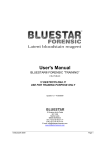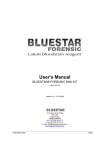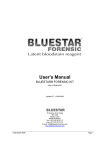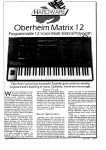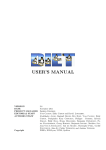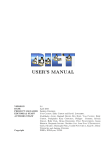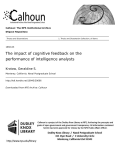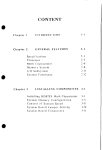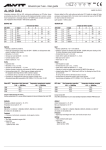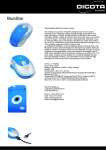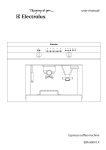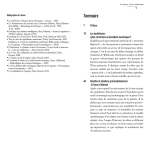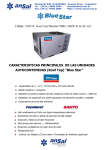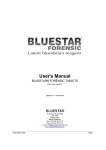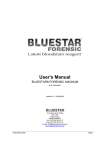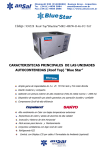Download "TRAINING" - 8 APPLICATIONS - user`s manual
Transcript
BLUESTAR FORENSIC Latent bloodstain reagent BLUESTAR® FORENSIC «TRAINING» Réf. BL-S08-TR .'.'.' DESTROYS DNA ! ! ! USE FOR TRAINING PURPOSE ONLY A - Technical Application Note The BLUESTAR8 FORENSIC is a patented powerful new latent bloodstain reagent that has been designed to reveal blood, either fresh, dried or still humid, washed away blood, pure or diluted, in large or minute quantity. The BLUESTAR* FORENSIC latent bloodstain reagent is extremely sensitive. Blood is detected on any background: material, animal or vegetable, in liquid or solid form. Blood may be detected either pure or diluted, while fresh, or long after it has been deposited (dried or even deteriorated). Furthermore, it allows for viewing thé blood traces even if they hâve been rinsed away, or cleaned away (even on minute blood amounts). The BLUESTAR® FORENSIC latent bloodstain reagent produces such an exceptionally bright chemiluminescence that complète darkness is not required for use, and no spécial photographie equipment is necessary to record thé évidence. Standard 35 mm caméras can be used with perfect results. The BLUESTAR8 FORENSIC latent bloodstain reagent is prepared within minutes. It is then applied lightly, in a mist, with a hand-held fine-spray bottle. The blue chemiluminescence produced by thé BLUESTAR" FORENSIC latent bloodstain reagent is still visible several minutes after thé bloodstains hâve been treated. To facilitate crime scène investigation, BLUESTAR» FORENSIC can be applied numerous times over thé same bloodstains. B - User's Manual The use of chemicals to investigate crime scènes is well known, and latent blood reagents such as Amido Black, Benzidine, Leucomalachite, Leuco Crystal Violet, Fluorescein, Luminol, Phenolphthalein, Herma-Glow, etc. hâve been applied for many years by forensic experts around thé world to detect blood in minute quantity; blood cells still présent in washed-away bloodstains; or blood otherwise invisible to thé human eye. Two main catégories of such chemicals exist for this purpose: -Those which react to thé proteins and amino acids contained in thé biological fluid: DFO, Amido Black, etc. - Those which detect an enzymatic activity: Benzidine, Leucomalachite green, Leucocrystal violet, Luminol, Fluorescein, etc. However, ail thèse existing chemicals suffer from some major drawbacks. Some are simply too toxic or too highly flammable to be used safely. Others severely compromise or prevent DNA typing, are not sensitive enough, and are difficult to use. Still others are highly unstable, hâve a very short life, are difficult to maintain in storage, or any combination of thé above... To solve thèse problems, Professer Loïc Blum, Ph.D., a recognized authority in chemiluminescence, and thé research team of thé Enzymatic and Biomolecular Engineering Laboratory of thé French National Center for Scientific Research (CNRS) at thé University Claude Bernard of Lyon UCBL, France, developed thé new latent bloodstain reagent BLUESTAR® FORENSIC. When placed in contact with thé iron contained in thé heme nucleus of blood hemoglobin, thé BLUESTAR» FORENSIC cata/yzes (enzymatic peroxydase activity) and emits an intense blue (430 nanometer) chemiluminescence, visible in thé dark. The BLUESTAR» FORENSIC can also produce a chemiluminescence when reacting to some household détergents such as bleach, or copper, but différences in intensity, émission spectrum, and reaction time, allow for Visual differentiation by experienced users. The BLUESTAR® FORENSIC latent bloodstain reagent is based on a new proprietary patented formula that is totally DNA typing compatible, extremely sensitive, stable, easy to use, and produces a very bright and long lasting chemiluminescence. However, thé spécifie BLUESTAR® FORENSIC "TRAINING" formula does DESTROY DNA and is therefore intended only for training purposes. Do NOT use BLUESTAR® FORENSIC "TRAINING" for actual investigations. 1 - MIXING INSTRUCTIONS Box content Each BLUESTAR® FORENSIC "TRAINING" box holds 2 tubes containing 8 pairs of tablets to make 8 x 125 ml (8 x 4 fl. oz) of BLUESTAR® FORENSIC chemiluminescent solution or I liter (32 fl. oz) if ail pairs are used together. Required items Prier to mixing thé product, you will need thé following items: - distilled water - spray bottle (mister) equipped with an adjustable spray nozzle Active life Best results are obtained when thé product is used within 3 hours after mixing thé tablets in water.There is therefore no requirement to rush thé investigation due to immédiate product détérioration. Covered area A 125 ml (4 fl. oz) dose is generally sufficient to investigate a 25 m2 (250 sq. ft.) area, to search a vehicle or an object (clothes, rug, knife, etc).A I liter (32 fl. oz) dose is generally sufficient to investigate about a 200 m2 (2,000 sq. ft.) area. Mixing procédure 1. Open thé spray bottle; add 125 ml (4 fl. oz) of distilled water. 2. Take a white tablet out of thé white-top tube and close thé tube immediately.Take a beige tablet out of thé orangetop tube and close thé tube immediately. DO NOT switch caps. The white cap goes on thé white-top tube and thé orange cap on thé orange-top tube. 3. Add thé pair of tablets to thé distilled water. If you need more working solution, use 125 ml (4 fl. oz) per pair of tablets. 4.Twist thé head with its plunger on thé spray bottle firmly. 5. Allow about I or 2 minutes for complète dissolution and mixing of thé chemicals, swirling gently with a circular motion of your hand. Do NOT shake thé container upside down. 2 - APPLICATION INSTRUCTIONS Lighting conditions The BLUESTAR8 FORENSIC latent bloodstain reagent produces a very bright and long lasting blue chemiluminescence that does not require total obscurity to be visible. However, at high blood dilutions, thé investigation will be much easier, and thé risks of missing a clue much lower, if thé product is applied in total darkness. Indoors: Close ail thé Windows, block ail outside light sources, and turn off ail thé lights. Outdoors: Wait for night time, and turn off ail area lights in an urban environment. If necessary, screen off distant light sources, or even a very bright moon, and work facing away from parasite lights. Wait for at least I minute to allow your eyes to adjust to darkness. Once your pupils hâve dilated you will be able to better observe thé BLUESTAR® FORENSIC reaction. Vaporization In order to prevent biological contaminations of thé revealed traces, wear personal protective equipment: safety goggles, gloves, dust respirator, protective clothing. Do not spray toward another person. The BLUESTAR® FORENSIC latent bloodstain reagent is designed to be vaporized from waist height in a fine mist. Adjust thé spray nozzle to obtain thé finest mist possible. Very little of it is actually needed. Over-spraying does NOT resuit in improved blood détection, and in case thé DNA is only available in very low quantifies, over-spraying might dilute it too much for collecting exploitable samples, thus compromising its analysis. Check how thé product reacts by spraying BLUESTAR8 FORENSIC on a testing sample.This test will also help you become familiar with thé reaction on blood. Spray lightly, horizontally ahead of you, at least 50 cm (2') away from thé target, in a side to side sweeping motion, NOT pointing toward thé ground. Indoors: Be attentive not to saturate'walls and vertical surfaces in order not to create drippings (as if you were spray painting). Outdoors: Pay attention to wind direction, if any. Do not spray into thé wind, but use it to carry a light cloud of product over thé area being searched. Identifying "false" reactions When reacting to blood, thé BLUESTAR® FORENSIC latent bloodstain reagent emits an intense light-blue chemiluminescence in thé 420 to 440 nanometer range. However, "false" reactions may occur due to thé présence of certain household détergents, chlorine, sortie paints and varnishes, copper, certain iron metabolizing plants such as lichens, thyme and some tree mosses, and certain soils containing iron. Such "false" reactions are easily identifiable by thé trained technician because their color, brightness, and duration differ from those of thé typical reaction on blood. Typically, "false" reactions are markedly dimmer and whiter. "False" reactions due to chlorinated détergents are often interesting, because they may reveal attempts to wash or clean bloodstains, and to conceal a homicide. 3 - PHOTOGRAPHE Photography of latent blood prints developed with chemiluminescence is not fundamentally différent from regular daylight photography. The same four basic éléments of photography (subject lighting,film sensitivity, aperture opening, and shutter speed) interact in exactly thé same way. Photography of BLUESTAR" FORENSIC detected blood prints is easy and produces excellent results. Equipment The chemiluminescence produced by thé reaction of thé BLUESTAR® FORENSIC latent bloodstain reagent to blood is bright enough that no spécial equipment is needed. However, relatively long exposures may be needed for maximum picture quality and a tripod and flexible cable release are highly recommended. This will ensure thé caméra is motionless during thé time of thé exposure. A 24 mm lens is recommended. Film No spécial film is required, but it is advisable to use lowlight fast films in order to obtain acceptably short exposure times.A film speed of ASA 400 is generally suitable. Lighting conditions Total darkness is not required. Natural low intensity diffused light is preferred.Artificial light (tungsten or fluorescent) produces yellowish or greenish pictures.A direct flash should be avoided. Instructions to obtain good pictures 1. Set thé cannera on a tripod, perpendicular to thé area being photographed. 2. Disable thé automatic flash and thé autofocus mode, if thé caméra has one. 3. Use a large lens aperture, typically a f/2.8 "f/stop" value. 4. Set thé exposure time to "B". 5. Focus thé lens manually over a spot of light provided by a flashlight over thé blood area. 6. Turn off ail lights. Darkness should not be complète. Pictures shot in dimmed light will allow you to view not only thé trace, but other détails of thé scène as well. 7. Re-spray thé blood print to reactivate a bright chemiluminescence reaction. 8. Shoot several pictures using différent shutter speeds, typically 30 seconds. 4 - COLLECTING BIOLOCICAL PRINTS Biological prints revealed with BLUESTAR® FORENSIC "TRAINING" do not allow for subséquent DNA analysis. For other purposes, samples of thé revealed biological prints are collected using thé same methods as for any kind of biological prints. 5 - STORAGE. CLEANINC & DISPOSAI Storage The BLUESTAR® FORENSIC "TRAINING" latent bloodstain reagent has a 3 year shelf life AFTER MANUFACTURING (expiration date imprinted on each cardboard box). Be certain to close thé tubes immediately with their respective caps after each opening. If you wish to use thé product after thé expiration date, we recommend that you perform a test to check thé product effectiveness. Note:The product is warranted for 2 years after thé DATE OF PURCHASE. DO NOT attempt to store thé product AFTER MIXING thé tablets with water.The mixed product is an active chemical compound that oxidizes. Inert gases are constantly released and will, in time, accumulate under pressure in a sealed container, causing swelling and leaking. Cleaning Since thé BLUESTAR* FORENSIC latent bloodstain reagent is designed to be used on presumed blood on crime scènes, ail précautions and régulations related to thé biohazards of blood apply when cleaning. Disposai Dispose of unused mix in a sink under running water. Dispose of cleaning residues according to local, state, and fédéral régulations applying to thé biohazards of blood. 6 - MATERIAL SAFETY DATA SHEETS Material safety data sheets (MSDS) for thé BLUESTAR® FORENSIC "TRAINING" are available in PDF format on our web site: www.bluestar-forensic.com/gb/download.php BLUESTAR 16 Avenue de la Costa - P.O. box 246 Monte Carlo - 98000 MONACO Tel. (+377) 97 97 31 77 - Fax (+377) 97 97 31 61 E-mail: [email protected] www.bluestar-forensic.com Update 08/30/2006 - © BLUESTAR® 2006


